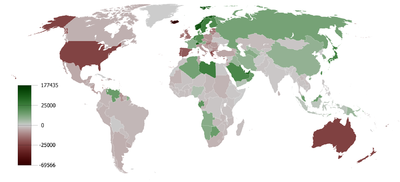
Back ميزان تجاري Arabic Ticarət balansı Azerbaijani Търговски баланс Bulgarian বাণিজ্য ভারসাম্য Bengali/Bangla Balança comercial Catalan Obchodní bilance Czech Handelsbalance Danish Handelsbilanz German Komerca bilanco Esperanto Balanza comercial Spanish


Balance of trade is the difference between the monetary value of a nation's exports and imports over a certain time period.[1] Sometimes a distinction is made between a balance of trade for goods versus one for services. The balance of trade measures a flow variable of exports and imports over a given period of time. The notion of the balance of trade does not mean that exports and imports are "in balance" with each other.
If a country exports a greater value than it imports, it has a trade surplus or positive trade balance, and conversely, if a country imports a greater value than it exports, it has a trade deficit or negative trade balance. As of 2016, about 60 out of 200 countries have a trade surplus. The notion that bilateral trade deficits are per se detrimental to the respective national economies is overwhelmingly rejected by trade experts and economists.[2][3][4][5]
- ^ O'Sullivan, Arthur; Sheffrin, Steven M. (2003). Economics: Principles in Action. Upper Saddle River, New Jersey: Pearson Prentice Hall. p. 462. ISBN 0130630853.
- ^ Cite error: The named reference
:15was invoked but never defined (see the help page). - ^ Cite error: The named reference
:0was invoked but never defined (see the help page). - ^ Cite error: The named reference
:1was invoked but never defined (see the help page). - ^ "What Is the Trade Deficit?". The New York Times. 9 June 2018. ISSN 0362-4331. Retrieved 10 June 2018.